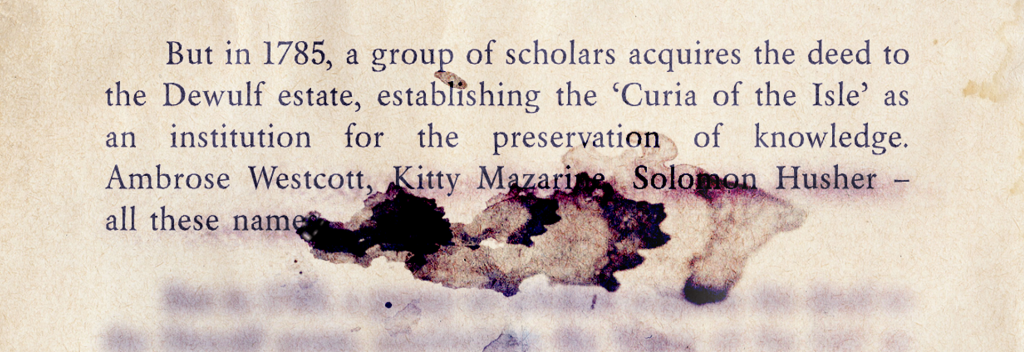
Reverend Timothy Speaks, Part One
“BOOKS ARE THE MEMORY THAT DOES NOT DIE.”
– Inscription above the door of Hush House
As Lottie and I work on BOOK OF HOURS, we’ve become better acquainted with the long and layered history of Hush House, the library where the game takes place. Lottie’s worked on recapturing the House’s look and feel over its many eras – Roman shrine, Dark Ages monastery, mediaeval abbey, baronial seat, institute of learning, and finally (whisper it) a highly select reformatory prison. I’ve been digging into the history of its inhabitants.
Resources on Hush House’s history are hard to come by (and no I can’t just make it up, good heavens). Fortunately on a recent research trip I happened across a 1930s tourist pamphlet produced by the rector of Brancrug Village.
I do take issues with some of Reverend Timothy’s scholarship. He passes over the details in the death of the sixth Baron Brancrug – did he leap, did he fall, was he pushed? – and he’s clearly a bit of an Eva Dewulf fanboy. But then, aren’t we all?
HUSH HOUSE – A Visitor’s Guide
by the Reverend Timothy MacDonald
(price fourpence)
Dear Visitor,
I would like to welcome you to Hush House, one of the unexpected treasures of our Cornish coast. I have set aside considerable time to research the thousand-and-a-half years of its history, and I am pleased to share the fruits of my researches with you.
The history of the House is complicated, and can be bewildering to the ‘uninitiated’! To ‘ease you in’, I have identified five distinct periods or ‘phases’ in Hush House’s history.
Access to Hush House is by appointment. Please inquire at the Rectory. I regret that tours are not possible at high tide, on Church holidays, or while the Moon is visible in the sky. All proceeds from the sale of this booklet, or donations to tours, will be donated to the St Rhonwen Trust for the Advancement of Education.
DAWN PHASE
In the sixth century, the Abbey of the Black Dove – sometimes called also the Abbey of the White Crow – is established as a double foundation of monks and nuns, surprisingly common in those Dark Ages. 599 A.D. is traditionally celebrated as the date of the Abbey’s foundation, although I believe the island church of Our Lady Beneath – regrettably unsafe to visit due to flooding and subsidence – dates from the third century.
The Abbey was subject to Danish raids on at least two occasions in the ninth century, although the raiders are also recorded as mercenaries quartered here against the incursions of Egbert of Wessex. One raider apparently becomes a brother of the Abbey under the name Thomas, and later rises to become Abbot. Abbot Thomas evidently finds it difficult to leave his savage past behind, and dies in circumstances too violent for me to describe here. “Live by the sword, die by the sword”!
SOLAR GOTHIC PHASE
The splendid Abbey Church we see today – St Brandans – dates from the eleventh century. The Watchman’s Tower and its fortified gatehouse were built in wood as a protection against Saxon rebels after the Conquest. They were later rebuilt in stone, after the Abbey gave shelter to a tree brought from Normandy by the new Earl of Cornwall. The tree is said to flower white, black and red in consecutive springs. Perhaps if you keep a sharp eye out, you can identify one of its descendants!
Its substantial expansion in the thirteenth century was funded by an endowment from Eva de Braose, a noble lady of the Marches whose husband was hanged under undignified circumstances. The Solarium and Chapter House date from this point. St Brandan’s is by now established as a centre of learning and healing, and no doubt they were of assistance to Lady de Braose in some manner.
The Winter Tower, later called the Long Tower, dates from 1322 – curiously, the same year as the collapse of the tower of Ely Cathedral. The Tower stands alone in the gardens, and is fortified to no obvious end. I have examined what remains of its frescoes and I believe it was built in dedication to the Sun Before Dawn, according to the pre-Reformation solar traditions.
The Barber’s Tower was constructed in 1450 to house the healer Natan of Regensburg – as a sanctuary or perhaps a prison, since Natan is a learned but a Hebrew gentleman, and his people are regrettably unwelcome in the Kingdom of England at this time. The Crucible Tower dates from a little later. The fire of 1929 has left this tower unsafe, and I recommend strongly against close inspection.
BARONIAL PHASE
In 1537, as part of King Henry’s reforms, John Tregonwell is appointed to investigate St Brandans. He uncovers evidence of indulgent, corrupt and scandalous behaviour. The monastery is dissolved and the isle of Brancrug granted to Hendrik Dewulf, one of Tregonwell’s captains, formerly a Guelders mercenary. Dewulf is clearly an uneducated and violent man, and he suppresses a local rebellion with intemperate brutality. One story tells of a local oracle who places a curse on Dewulf in revenge: “There will be no seventh of his line.” Dewulf has the man dragged before him, tells him “There will be no second of yours,” and unmans the oracle with his own knife!!
Nevertheless, the Dewulfs grow more temperate over time. They treat the Abbey Church with respect, and their seat, Brancrug House, is the core of the other buildings that grace the Isle today. Thomas Dewulf, the second Baron, is nicknamed Baron Silence by the poets and playwrights of London – this I believe may be the origin of the later Hush House ‘moniker’!
Thomas restores the Watchman’s Tower and builds an observatory there in 1576 – with some foresight, since the Great Comet passes in 1577. His son Giles runs away with a Bristol girl, although he and his father are ultimately reconciled. The Bristol girl, named Hafren, has the pale hair and eyes notable in the later Dewulfs.
The third Baron, Walter, remodels much of the interior of Brancrug House. Many of his innovations have been lost beneath later work, but you can still admire the Grand Ascent that unites the House’s various levels. Walter supports King Charles in the Civil War, but in 1648, Walter’s son Bryan is hanged for treason that same King’s men. Walter’s heart bursts with sorrow, and his son post mortem receives special dispensation to be buried with his father. You may see their gravestones to this day, just to the west of the church.
In the 1650s, The fourth Baron, Musgrave, ‘the Lamb Dewulf’, restores the Winter Tower as a residence for Julian Coseley, the scholar and antiquary, who assists with the cataloguing and expansion of the library. Musgrave’s son, Gideon, is wickedly nicknamed ‘the Motley Baron’ for his odd and brindled appearance, and so the Motley Tower – once the Barber’s Tower – wins its name.
The sixth and last Baron is Valentine, an eccentric gentleman who builds the Gullscry Tower to house his aviary-collection. When Valentine falls to his death from the tower top, his daughter Eva inherits the estate at the age of nineteen.
Educated visitors will already know the name of Eva Dewulf, the Pale Lady, who cuts quite the ‘figure’ at court! Alas she is engaged to a rapscallion named Abraham Wheelock, who abandons her at the altar. Eva returns to Brancrug to recover, and is not seen at court again. However three days after her departure, Wheelock’s body is found on the beach near Gravesend. His face is so badly pecked by birds that he is only identified by his belongings. These include a waxed pouch containing a letter addressed to Wheelock, whose contents seem to show he is a spy in the pay of the Austrians! I suspect the matter has been ‘over-egged’, but Lady Eva no doubt would have found it all something of a relief.
Lady Eva never marries. She opens her library and draws visitors from across Europe and beyond. Some of these visitors are selected by peculiar and exacting criteria to attend sophisticated feasts in her Hall of Division. Others are drawn by Lady Evan’s reputation for scholarship – including the notorious Franklin Bancroft, whose deep friendship with Eva inspires wicked gossip.
THE CURIA PHASE
In 1759 Lady Eva’s heir, Captain Sebastian Dewulf, is drowned in battle against the French at Quiberon Bay. Lady Eva comes to a tragic end, and the Dewulf line ends. Brancrug House is all but abandoned, and the caves beneath the island become a smuggler’s haunt.
But in 1785, a group of scholars acquires the deed to the Dewulf estate, establishing the ‘Curia of the Isle’ as an institution for the preservation of knowledge. Ambrose Westcott, Kitty Mazarine, Solomon Husher – all these names
[water-stained and unreadable beyond this point]

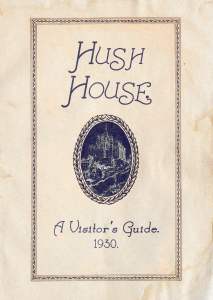
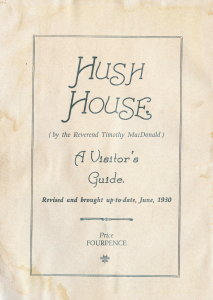

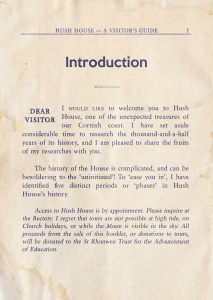
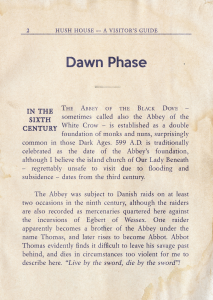
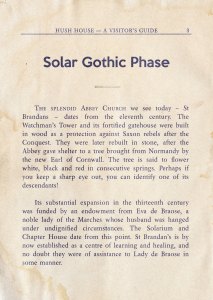
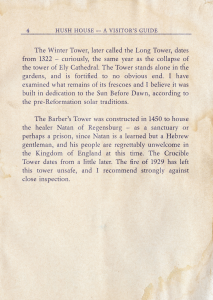
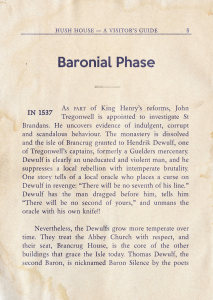
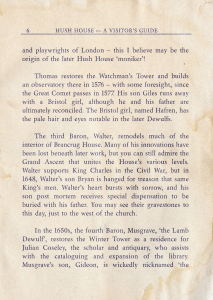
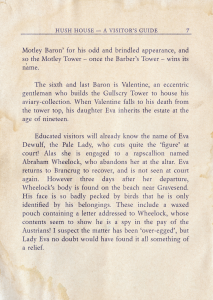
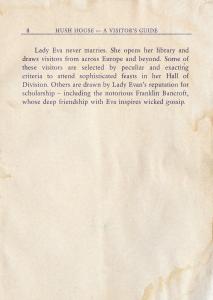
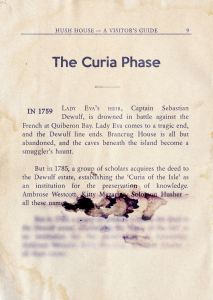


This is beautifully written.